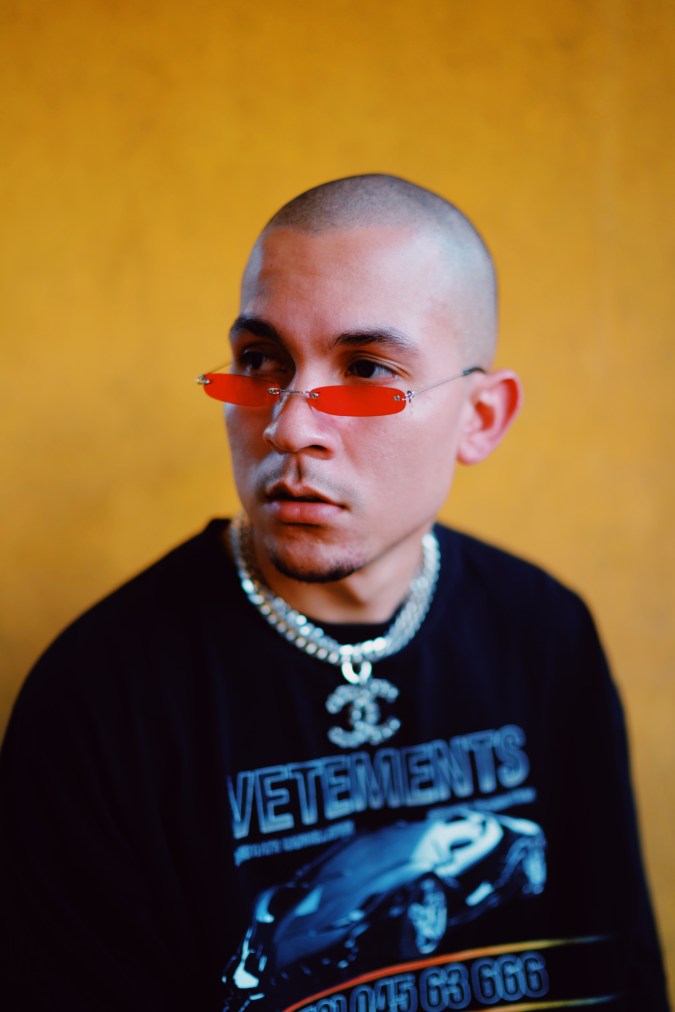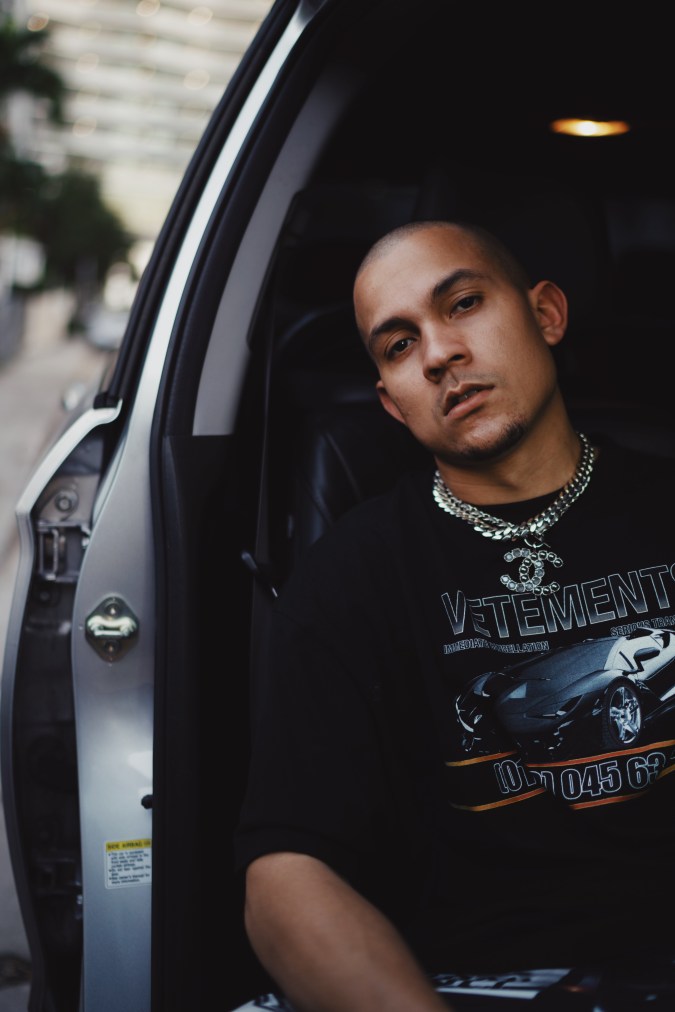For some producers, being nominated for a Grammy 14 years after your debut in the industry would be the culmination of over a decade of hard work, persistence, and sacrifice. For Tainy, it most certainly is all that — but it’s also the beginning of what he considers the next transformative phase of his career, which is only something you can say when you got your start as a 15-year-old and eventually became one of the architects of contemporary reggaetón.
Tainy, whose real name is Marcos Masís, turned 29 just four months before his Record of the Year nomination for Cardi B’s summer anthem “I Like It” was announced. But before that, Masís had spent his late teens and 20s rewriting the script on reggaetón, infusing the genre with electronic whimsy, melody, and addictive R&B, producing some of the mid-2000s’ indisputable reggaeton bops. Name a reggaetón track that you heard at a pari de marquesina back in the day, and there’s a good chance Tainy was behind the boards. Daddy Yankee’s “Impacto”? That’s a Tainy co-production. “El Telefono” by Wisin y Yandel and Hector El Father? Tainy. “Abusadora” by Wisin y Yandel? You guessed it – Tainy again.
His success in the genre catapulted him to mainstream fame, which eventually led to the opportunity to collaborate with Cardi B on “I Like It.” The track also features Bad Bunny and J Balvin; Tainy worked with the latter on his fifth album Vibras, and the former recruited him for his own expansive debut full-length X100PRE, which was released this past Christmas Eve and is widely considered one of the most innovative and experimental projects in today’s mainstream urbano universe.

“I can hardly put it into words, to be honest. The nomination was definitely a blessing and game changer,” he says, “for me and also for our music, to be able to see its reach.” Now Masís intends to build upon a successful 2018 and dig into a forthcoming dream project: his own full-length studio album.

“I never imagined the genre would have the success it has now. I’m still trying to process it, seeing how it went from where it was back in 2004 to now.”
The project will feature an eclectic mix of acts drawing from a pool of both reggaetón artists he’s collaborated with in the past and also a “wish list” of Anglo artists he’s “always dreamt of working with.” The key difference this time, and the most attractive aspect of the whole endeavor, is the absolute freedom Tainy will have on the production side. “This will be the first time I have 100 percent control over what I’m creating,” he notes. “In this case, it would be the artists entering my world, and not [me producing] 50-50 with them or me trying to add to their ideas.”
In contrast to the English-language market, where producer-as-artist albums are often EPs or mixtapes but wide studio releases are reserved for superstar names like Calvin Harris, Major Lazer, or DJ Khaled, this was not the case in Tainy’s home of Puerto Rico. From the inception of the genre, reggaetón producers like DJ Joe, DJ Blass, Echo, Nesty, and many others steadily released their own compilations featuring the buzziest artists of the moment. Arguably the most popular and influential of all of these were Luny Tunes, a production duo who revolutionized the genre with their debut Mas Flow back in 2003. Three years later, they released Los Benjamins and touted their brand-new signee, a fresh-faced 17-year-old Masís, who at that young age, had impressed them with his homemade beats and were eager to put him in a professional setting and hear the results. The chance to revive the records he grew up listening to isn’t lost on Tainy, who realizes that “the opportunity to work on a project like the kind that gave me my start is very exciting for me.”
Tainy has a reputation for working tirelessly, even when he doesn’t have a formal project in front of him, so it’s no surprise he’s amassed a treasure trove of unused beats. The production for fan-favorite track “RLNDT” from Bad Bunny’s album, for example, was one he’d made in his spare time nearly three years earlier. For his own album, though, he intends on drawing up entirely new music “from scratch” and is currently in that phase of the project. “Right now, I’m working on the instrumentals [and] trying to pin down what will be the color and sound of the [album],” he shares. “Once I have that I’ll turn around and think on whose voice or what mix of artists fit.” That being said, he shares that Bad Bunny, J Balvin, and Ozuna are some of the artists who are confirmed to participate in the compilation, which will be released under Roc Nation’s label.

“We have to be grateful, not settle, and keep working hard to see how far we can keep taking it because I feel there’s no limit.”
Tainy hopes to insert the dynamism and essence of Puerto Rico into the project, even if it’s in small doses. “We’re going to have Puerto Rican artists and any small details we can include in the lyrics and such to represent [that is] something that I’ve had in mind.” While he was not present on the island during Hurricane María, he still remembers how distraught he felt when he was finally able to return. “I drove the old route I’d always take going to school back when I studied in Old San Juan and it looked like out of a movie in the worst way. It was very shocking to see things so different from how I remembered them.”
Masís belongs to a unique fraternity of producers who were recruited at a very young age by reggaetón imprints that were eager to expand and amplify their sound. They saw potential in Fruity Loops-savvy teens who conjured beats out of their bedrooms and shared their pistas online in dedicated forums. Nely “El Arma Secreta” and Mambo Kingz, all of whom still work regularly today, can consider themselves part of the same generation. But Masís is conflicted about the next wave of creators who enter the business when they are still barely high school sophomores. “It’s a lot that falls on your lap at that age, first on the creative side and dealing with artists, but also on the business side, where we started out so young that we didn’t know anything. So a lot of these young producers can get taken advantage of if they’re not working with trustworthy people.” To this end, he reveals that he’s mulling over the idea of starting a mentorship and education program for young producers. “I’d like to contribute to that, because at that age, the paperwork regarding labels and publishers can be overwhelming, and since you don’t know what you’re signing, you can end up trapped.” He does acknowledge that starting young means that he had the benefit of time to make mistakes and bounce back, and also be able to accumulate a large audience while still “a 29-year-old kid.”

“The time that’s passed has trained me for where I am now,” he continues. “I never imagined the genre would have the success it has now. I’m still trying to process it, seeing how it went from where it was back in 2004 to now, and everything it had to go through to get here. But now we have to be grateful, not settle, and keep working hard to see how far we can keep taking it because I feel there’s no limit.” Considering his inimitable legacy on the movement, don’t be surprised if this next chapter leaves another indelible mark on the sound of urbano.





